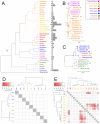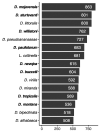Horizontal transfer and the widespread presence of Galileo transposons in Drosophilidae (Insecta: Diptera)
- PMID: 38569056
- PMCID: PMC10990002
- DOI: 10.1590/1678-4685-GMB-2023-0143
Horizontal transfer and the widespread presence of Galileo transposons in Drosophilidae (Insecta: Diptera)
Abstract
Galileo is a transposon notoriously involved with inversions in Drosophila buzzatii by ectopic recombination. Although widespread in Drosophila, little is known about this transposon in other lineages of Drosophilidae. Here, the abundance of the canonical Galileo and its evolutionary history in Drosophilidae genomes was estimated and reconstructed across genera within its two subfamilies. Sequences of this transposon were masked in these genomes and their transposase sequences were recovered using BLASTn. Phylogenetic analyses were employed to reconstruct their evolutionary history and compare it to that of host genomes. Galileo was found in nearly all 163 species, however, only 37 harbored nearly complete transposase sequences. In the remaining, Galileo was found highly fragmented. Copies from related species were clustered, however horizontal transfer events were detected between the melanogaster and montium groups of Drosophila, and between the latter and the Lordiphosa genus. The similarity of sequences found in the virilis and willistoni groups of Drosophila was found to be a consequence of lineage sorting. Therefore, the evolution of Galileo is primarily marked by vertical transmission and long-term inactivation, mainly through the deletion of open reading frames. The latter has the potential to lead copies of this transposon to become miniature inverted-repeat transposable elements.
Conflict of interest statement
Figures



Similar articles
-
Structural and sequence diversity of the transposon Galileo in the Drosophila willistoni genome.BMC Genomics. 2014 Sep 13;15(1):792. doi: 10.1186/1471-2164-15-792. BMC Genomics. 2014. PMID: 25218200 Free PMC article.
-
The Foldback-like element Galileo belongs to the P superfamily of DNA transposons and is widespread within the Drosophila genus.Proc Natl Acad Sci U S A. 2008 Feb 26;105(8):2957-62. doi: 10.1073/pnas.0712110105. Epub 2008 Feb 19. Proc Natl Acad Sci U S A. 2008. PMID: 18287066 Free PMC article.
-
Striking structural dynamism and nucleotide sequence variation of the transposon Galileo in the genome of Drosophila mojavensis.Mob DNA. 2013 Feb 4;4(1):6. doi: 10.1186/1759-8753-4-6. Mob DNA. 2013. PMID: 23374229 Free PMC article.
-
Horizontal transfer of P elements and other short inverted repeat transposons.Genetica. 1992;86(1-3):275-86. doi: 10.1007/BF00133726. Genetica. 1992. PMID: 1334912 Review.
-
Modern thoughts on an ancyent marinere: function, evolution, regulation.Annu Rev Genet. 1997;31:337-58. doi: 10.1146/annurev.genet.31.1.337. Annu Rev Genet. 1997. PMID: 9442899 Review.
References
-
- Acurio AE. Coevolutionary analysis of the transposon Galileo in the genus Drosophila. Autonomous University of Barcelona; 2015. 219 M. Sc.
-
- Antoniolli HRM, Deprá M, Valente VLS. Patterns of genome size evolution versus fraction of repetitive elements in statu nascendi species: the case of the willistoni subgroup of Drosophila (Diptera, Drosophilidae) Genome. 2023;66:193–201. - PubMed
-
- Bailly-Bechet M, Haudry A, Lerat E. “One code to find them all”: A perl tool to conveniently parse RepeatMasker output files. Mob DNA. 2014;5:13
Internet Resources
-
- TaxoDros The database on Taxonomy of Drosophilidae v1.04. [10 April 2023]. 04 , https://www.taxodros.uzh.ch/
-
- Blin K. NCBI Genome Downloading Scripts. 2021. [10 November 2022]. Blin K (2021) NCBI Genome Downloading Scripts, https://github.com/kblin/ncbi-genome-download/
-
- McGowan J. jamiemcg/BUSCO_phylogenomics: BUSCO v4. 2020. [8 April 2023]. McGowan J (2020) jamiemcg/BUSCO_phylogenomics: BUSCO v4 , https://zenodo.org/records/7334954 .
-
- Rambaut A. FigTree v1.4.4. 2018. [9 April 2023]. 4 , https://github.com/rambaut/figtree/
-
- Smit A, Hubley R, Green P. RepeatMasker 4.0. 2023. [10 November 2022]. 0 , http://www.repeatmasker.org/
LinkOut - more resources
Full Text Sources
Molecular Biology Databases

